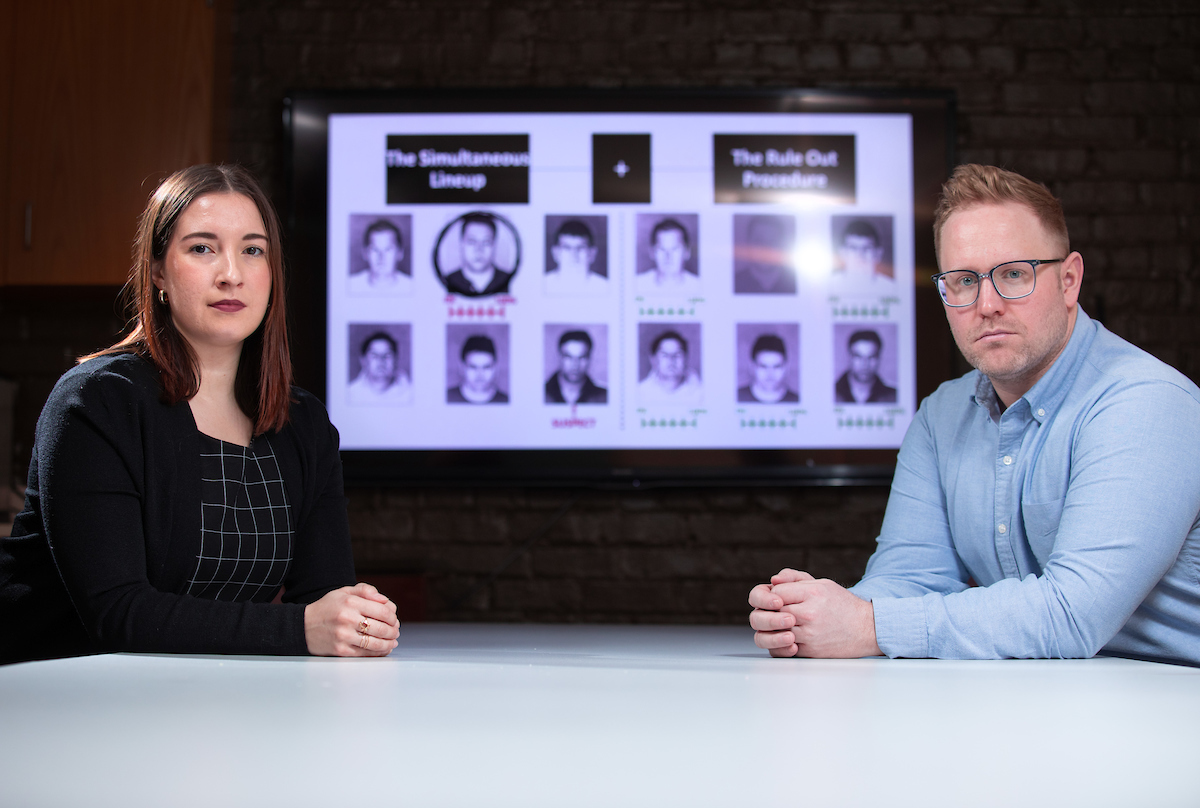
Nydia Ayala, left, and Andrew Smith in psychology have developed a revised method for an eyewitness lineup. Larger image. Photo by Christopher Gannon/Iowa State University.
AMES, IA – Iowa State researchers have developed a new procedure to capture more information from eyewitnesses during police investigations and better detect a suspect's guilt or innocence.
During a typical eyewitness lineup, police display a “six pack” of photos. One is the police suspect. The other five are “fillers;” they fit the description of the culprit, but the investigators know they are innocent. The witness selects the person who best matches their memory or rejects the whole lineup if they don’t think the culprit is present. Investigators following best practices then ask the witness to rate how confident they are in their decision.
Previous studies have found a high confidence rating from eyewitnesses (i.e., 90% or more) implies greater accuracy. But when an eyewitness picks a filler or rejects the whole lineup, which happens in an estimated 24% and 35% of lineups, respectively, investigators miss out on potentially valuable evidence.
“The standard eyewitness line-up is a helpful tool for investigators, but it could be better and provide a lot more information,” said Andrew Smith, a cognitive psychologist and assistant professor at Iowa State.
Smith and Nydia Ayala, a fourth-year Ph.D. student, are interested in memory and decision-making in the context of the criminal justice system. Over the last three years, they’ve developed and repeatedly tested what they call the “Simultaneous Lineup Plus Rule Out Procedure.” Their latest study, published in Psychology, Public Policy and Law, adds to their findings that the procedure improves the accuracy of lineups and can help inform investigations.
Enhancing, not erasing
“One of the benefits of the rule out procedure is it’s highly feasible,” said Ayala. “We're not asking investigators to stop doing standard simultaneous lineups with six packs. We’re just asking them to tack six confidence questions onto the end."
With the researchers’ proposed change, eyewitnesses would still make an initial selection or rejection of the whole lineup and give a confidence rating for their decision. But then they’d look again at each of the photos they did not select from the first round and answer: how confident are you this is not the culprit?
“This ensures that even when a witness picks a filler or rejects a lineup, they still tell police something that speaks directly to the likelihood that the suspect is guilty or innocent. We’re not getting that with the standard lineup,” said Smith.
To show how this could be beneficial, Ayala gave the example of an eyewitness who selects the second face in a six pack with 60% confidence. If the second face was a filler, police following the standard lineup procedure would not receive any information about their suspect, the fourth face. With the new method, the eyewitness might look at the fourth face in the lineup and say the individual was not the culprit with 100% confidence. This could indicate that the police’s suspect is innocent.
“If cops use this procedure, they're going to do much better at knowing if they’re on the right track or need to go back to the drawing board,” said Smith. “It might also make for compelling evidence in court cases when defense lawyers have a witness who is able to say, ‘I’m 100% sure it is not that guy.’”
Results
In the researchers’ latest study, 3,281 participants watched a 90-second simulated crime video. The culprit’s face was in view for 45 seconds. After, the participants worked on word scrambles for four-five minutes to prevent them from rehearsing the image of the culprit. The researchers explained this was built into the experiment to mimic the natural passage of time real eyewitness experience between viewing a crime and completing a lineup.
The participants were randomly assigned to the standard lineup or rule out procedure and informed that they may or may not see the culprit from the video among the photographs.
With the standard lineup experiment, the researchers found that 11% of the participants who viewed a lineup that did not include the culprit were 100% confident in rejecting the whole lineup. They were accurate 81% of the time. But with the rule out procedure, nearly half (43%) of the participants said they were 100% confident that the innocent suspect was not the culprit, and their accuracy increased to 87%.
“That bump in accuracy from 81% to 87% was relatively small, but it’s not the whole story because the rule out procedure also drastically kicked up the number of people who can give high confidence rejections, which are highest in accuracy,” said Smith.
Essentially, the rule out procedure could mean more witnesses are able to indicate the likelihood that the suspect is guilty or innocent. Smith and Ayala say it’s time for the criminal justice system to move beyond standard lineups and adopt the rule out procedure.
Contacts
Andrew Smith, Psychology, amsmith@iastate.edu, 515-294-9245
Nydia Ayala, Psychology, ntayala@iastate.edu
Rachel Cramer, News Service, rcramer@iastate.edu, 515-294-6316
Quick look
Iowa State researchers have developed and repeatedly tested a procedure that captures more information from eyewitnesses and improves the accuracy of lineups in police investigations.
Quote
“If cops use this procedure, they're going to do much better at knowing if they’re on the right track or need to go back to the drawing board.”
Andrew Smith, assistant professor of psychology
Read the paper
“The Rule Out Procedure: A Signal-Detection-Informed Approach to the Collection of Eyewitness Identification in Evidence.” Psychology, Public Policy, and Law, Dec. 2022.
More news
Find more Iowa State University news and research stories at news.iastate.edu.